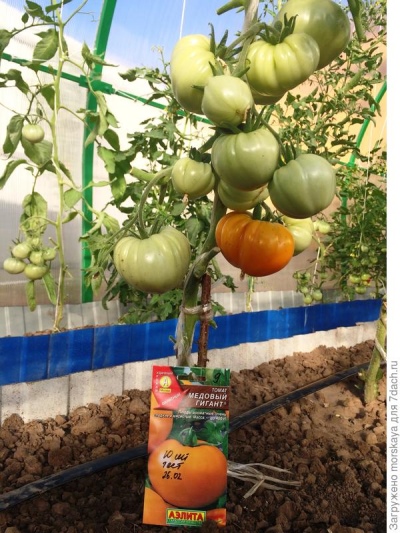
- Authors: Nastenko N.V., Kachainik V.G., Gulkin M.N.
- Year of approval: 2013
- Category: grade
- Growth type: indeterminate
- Appointment: fresh consumption
- Ripening period: mid-season
- Ripening time, days: 110-115
- Growing conditions: for open ground
- Transportability: Yes
- Bush height, cm: 180
The name of the tomato, Honey Giant, is promising. But it is very important not to trust him blindly, but to carefully study all the features. Only then will it be possible to provide an excellent result.
Breeding history
The honey giant appeared relatively recently. This variety was officially registered in 2013. It was created by breeders Nastenko, Kachainik, Gulkin.
Description of the variety
The honey giant has a good indeterminate development. It is ideal for outdoor use. The bushes of this tomato grow up to 1.8 m. Moderately large leaves are formed on them. For such foliage, a light green color is characteristic.
The main qualities of the fruit
Light green berries have green spots at the base. When they are ripe, they will turn orange in color. Large tomatoes weigh 250-300 g. Flat-round shape and rather pronounced ribbing are typical for them. Tomatoes will develop on simple inflorescences, and the stalks are devoid of articulation; excellent keeping quality is typical.
Taste characteristics
The honey giant tomato is sweet to taste. Its pulp is of medium density. The fruit is characterized by a slightly pronounced fruity aroma.
Ripening and fruiting
The honey giant is classified as a mid-season crop. Normally, it matures in 110-115 days. You can pick berries in July, August and September. Meteorological conditions can make serious changes.
Yield
The productivity level is pretty high. It can be 7.5-8 kg per 1 sq. m. However, this indicator is achieved only with a good agrotechnical approach.
The timing of planting seedlings and planting in the ground
It is necessary to sow seeds in containers in the first half of March. It is necessary to transfer the seedlings into the ground from May 15. The deadline is June 5th. Specific conditions are chosen at their discretion. Take into account the readiness of both seedlings and soil.

Growing tomato seedlings is an extremely important process, because it largely depends on whether the gardener can harvest at all. All aspects must be taken into account, from seedbed preparation to planting in the ground.
Landing scheme
Usually, the bushes are arranged in a 500x600 mm system. Gardeners use other options strictly at their own peril and risk.

Growing and caring
Berries almost never crack. But too high humidity can still lead to cracking.Before planting, the seeds are treated with a solution of potassium permanganate and germinated in wet gauze. The planting mixture is made up of:
turf land;
peat;
a set of mineral fertilizers (all of which are used in the same quantities).
The land for the main cultivation is disinfected with potassium permanganate. Trellis or garden nets are used to fix the bushes. Water each plant abundantly so that there is no lack of moisture. It is supposed to form a culture in 1-2 stems. This goal is achieved by pinching the lateral shoots and removing the growth point.
Instead of ordinary water for irrigation, a solution of potassium permanganate mixed with wood ash is often used. Watering is most often carried out strictly at the root. The only alternative is the drip irrigation system. On ordinary days, the bushes are watered once every 10 days. If the heat comes, you will have to do this once a week or even more often.
Top dressing can be combined with watering. This involves the use of liquid or water-soluble substances. In case of a lack of minerals, the use of foliar dressings is recommended. Loosening and feeding combined successfully replaces mulching. It is advised to lime acidic soil before planting.




A plant needs different micronutrients at each stage of growth. All fertilizers can be divided into two groups: mineral and organic. Folk remedies are often used: iodine, yeast, bird droppings, eggshells.
It is important to observe the rate and period of feeding. This also applies to folk remedies and organic fertilizers.
Disease and pest resistance
Resistance to pathologies and harmful insects is provided only under the condition of systematic processing. If it is not carried out, the natural resistance is low. The fight against late blight and other fungal infections can be carried out only with proper crop rotation. It will be necessary to ventilate the greenhouse and regularly loosen the ground. It is necessary to spray the plantings:
bordeaux liquid;
kefir;
copper sulfate;
calcium nitrate.


Growing regions
The honey giant is allowed to be cultivated in:
Western and Eastern Siberia;
regions of the Far East;
Volga and Volga-Oka regions;
regions and republics of the Urals;
the center of the Black Earth Region;
territories and republics of the North Caucasus;
regions of the center, north and northwest of the European part of the Russian Federation.
Review overview
The bushes of the Honey Giant are invariably strong and powerful. The taste fully meets expectations, sometimes even surpasses them. When growing this variety for several years in a row, complaints do not arise. The appearance of the berries is in complete harmony with their consumer qualities. Having tried such a culture once, they almost always decide to continue this practice.

























































































